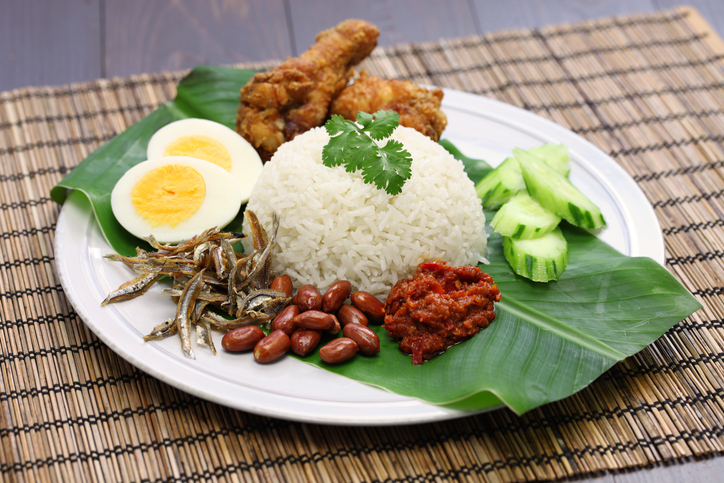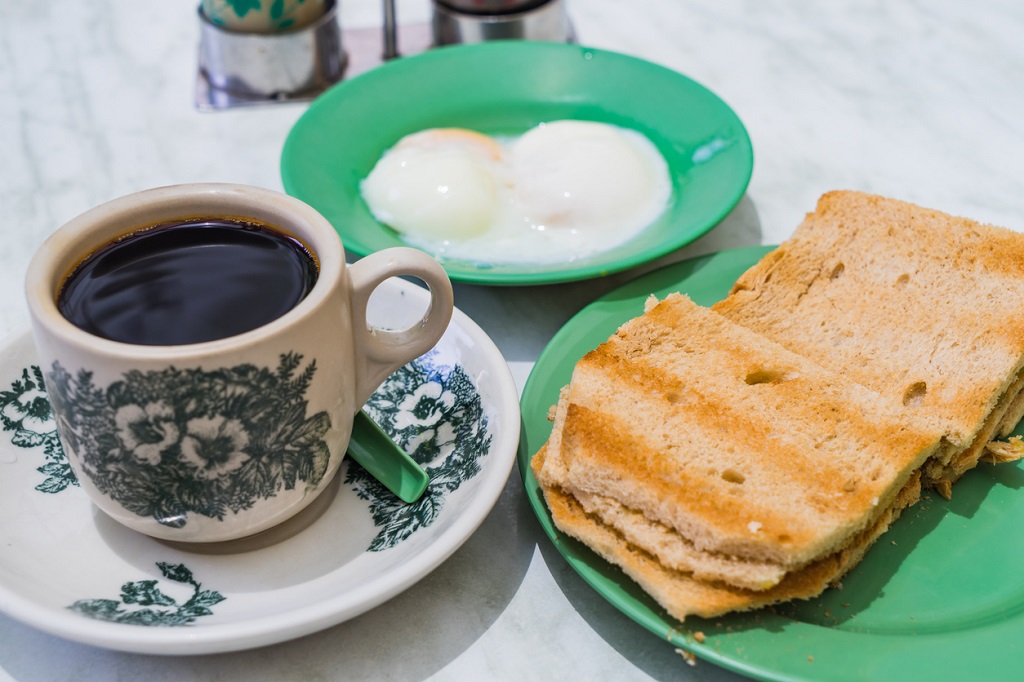Singaporean cuisine just like its society is a melting pot of different cultures incorporating a rich heritage of different food dishes. While it may be small in size, Singapore makes up for it with an astonishing culinary variety. So much so that it is safe to say that Singapore is a Foodie Haven! The cuisine consists of Chinese, Indian, Malaysian and Indonesian influences. So prepare to gorge on this thriving blend of cultures and cuisines which contains: classic Malaysian laksa and Indonesian satays, to southern Indian curries and spicy Chinese stir-fries.
Also Read: Why Is Singapore A Hard To Beat Tourist Destination?
We have narrowed down 11 best dishes (it wasn’t easy) from Singaporean cuisine that you cannot miss while you’re there next:
1Hokkien Mee

One of the most popular fried noodle hawker dishes in Singapore, Hokkien Mee has roots in China’s Fujian province. It features a mixture of egg noodles and white rice noodles that are fried in a rich prawn stock with cubes of fried pork fat, prawns, fish cake and squid. Different hawkers prepare it differently; some even add pork strips as well to add more flavour.
Typically Hokkien Mee is served with some sambal chilli sauce, a light soy sauce and a lime wedge, to tone down the oily taste.
2Bak Kut Teh

With Chinese origins, Bak Kut Teh literally translates to pork bone tea. A popular dish in Malaysian and Singaporean Cuisine, it is said to have been developed by Hokkien immigrants from China.
Although one would think the pork is cooked in tea, tea is not included in the recipe. Its basic recipe includes juicy pork ribs, simmered for hours in a rich herbal broth along with white pepper, lots of garlic, and salt until the pork becomes tender. This highly complex soup demands the right quantities of ingredients such as star anise, cinnamon, cloves, fennel and dang gui to achieve the best flavour. Usually accompanied by a bowl of steamed rice and often with some other Chinese side dishes like preserved mustard greens or braised tofu.
3Fish Head Curry

Originally from India, this dish has either half the head or the whole head of a red snapper stewed in curry. The curry is of a rich yet thin Keralan variety, with assorted vegetables like brinjal (eggplant) and Lady’s Finger (okra) that are often added for texture.
While the Indian-style of curry has heavier spices and flavours, the Chinese-style is lighter and sweeter. But the most unusual variant is the Assam-style, which has an added tinge of sourness from tamarind.
4Char Kuay Teow

When it comes to stir-fried noodles in Singaporean Cuisine, one of the ultimate local favourites is char kway teow. Made with flat rice noodles, prawns, eggs, slices of Chinese sausages, bean sprouts, Chinese chives and shrimp-paste, this is another hard to resist Singaporean dish. It is stir-fried over very high heat with a dark chilli soy sauce and blood cockles to finish it off.
5Curry Laksa

The hallmark of Peranakan cuisine, this dish melds Malay and Chinese influences to give you thick rice noodles in a rich, spicy broth and a generous serving of prawns, slices of fish and cockles. There are many different types of laksa, some that include rich coconut milk, and others that are more water-based. You can find these variants of laksa, differing in the type of fish used, broth and even noodles. In spite of the differences, all types of laksa include diced greens such as onion, pineapple, chilli and cucumber, along with Vietnamese mint and bunga kantan (torch ginger) for taste.
Curry Laksa which is more predominant in Singapore uses vermicelli, coconut milk, tau pok (beancurd puffs), fish slices, shrimp and hum (cockles).
6Hainanese Chicken Rice

Hainanese Chicken Rice is one of Singapore’s most well-known and celebrated dishes. This delightful combo came with Hainan immigrants and is prepared with a whole chicken steeped in sub-boiling pork and chicken bone stock until cooked. It is then sliced, and presented with rice cooked in chicken stock, ginger, garlic and occasionally pandan leaves for added fragrance. A hot chilli dip (made with garlic and red chilli) is served alongside, topped with heaped spoons of chopped ginger and sweet dark soy sauce.
7Chilli Crab

Often referred to as one of the national dishes of Singapore, chilli crab is one of the most beloved special family dishes in Singapore. A whole hard-shelled mud crab is stir-fried, either dry with black pepper sauce or in a thick chilli and tomato sauce which is sweet and salty with a hint of sourness. Both are mouth-watering and are served along with fried mantous (buns), which are dipped in the luscious chilli sauce.
Also Read Singapore: 12 Why’s and What’s Of The Asian Country!
8Bak Chor Mee

Literally translated as “minced meat noodles”, Bak chor mee is a noodle dish with minced pork, liver usually consisting of egg noodles topped with a sauce made with vinegar, chilli, and soy sauce. This true Singaporean dish is typically ordered ‘dry’ and with a light broth soup on the side, to savour the full flavours of the sauce. You can choose between chilli or ketchup, and the type of noodles that you would like.
9Nasi Lemak

This deeply-rooted Malay coconut rice dish is a versatile guilty pleasure. It has fragrant rice cooked with coconut milk, salt, and traditionally wrapped in banana leaves to give it a wonderful fragrance. A typical Nasi Lemak set contains some type of sambal chilli sauce, peanuts, egg and fried anchovies (Ikan Bilis). A dish that is popular throughout Malaysia and Singapore, Nasi Lemak adds a twist to just an ordinary plate of steamed rice with side dishes.
Other races have adopted this dish with their own variations and offer a wide selection of additional ingredients like fried chicken drumsticks, luncheon meat and sotong (cuttlefish) balls.
10Sambal Stingray

Known as Ikan Bakar (‘barbequed fish’) in Malay, sambal stingray is popularly served at open-air bbq restaurants and food stalls in Singapore. To prepare this Singaporean invention, the stingray is cut into steak sized pieces, marinated in a sambal sauce. The fish is then wrapped in a banana leaf and grilled over, retaining its natural flavours. The Sambal sauce is a mixture of chillies, belacan (shrimp paste), shallots, spices and Indian walnuts is smothered generously all over the top. It is often finished with cane sugar, a pot of cincalok (fermented krill) and a squirt of calamansi juice (a sour, lime-like fruit).
11Kaya Toast and soft boiled eggs

This simple toast is prepared on a bread grill, slathered with coconut or egg kaya (a creamy spread made with coconut milk, caramelized sugar, and eggs), then slapped with a thick slice of butter that slowly melts within two slices of warm bread. This typical Singaporean breakfast is often served with soft boiled eggs and soy sauce on the side. With a light sprinkling of white pepper and a splash of soy sauce, this delicious dish can be best enjoyed with a sweet, milky coffee as well.
12Satay

Although originally from Indonesia with influence from India and the Middle East, satay (or sate) is very popular throughout Southeast Asia, and common to find at hawker food centres throughout Singapore. It is a dish of skewered, turmeric-marinated meat that is grilled on an open fire. Usually, the meats can include chicken, beef, mutton and even pork. Satay is typically served with Ketupat (rice cake), onions, cucumbers and a spicy peanut dip.
Also Read A Guide to the Top 30 Places to Visit in Singapore
Have you had any of these tempting dishes from Singaporean Cuisine before? Go on this Food Adventure and do let us know about your experiences in comments below!


